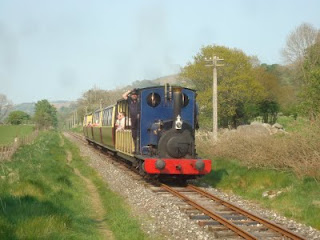
A week in Wales
11th May 2011
Sometimes Curators go on holiday! And where better than mid Wales, where (just by chance!) there are a number of narrow gauge railways to visit and enjoy…
Below: Heading west it is nice to break the journey, in this case at the Bala Lake Railway. Here Quarry Hunslet ‘Holy War’ drifts westwards with the last train of the day.
Below: ‘Holy War’ moves on shed after its operating day, passing two newly restored Dinorwic slate wagons on the left.
Below: Inside the shed are fellow Quarry Hunslets ‘Maid Marian’ (far right), ‘Alice’ (foreground, without boiler) and ‘George B’ (no boiler, middle left). To the left is the cab of Peckett ‘Triassic’.
Below: The Talyllyn celebrates 60 years of preservation this year, and perhaps if it hadn’t succeeded then the preservation World we enjoy today would have been a very different place. A key instigator in the scheme was Tom Rolt, and here is the engine named after him, Barclay/Pendre built No.7 standing at Tywyn Wharf Station with the 10:30am departure.
Below: Midway up the line is Dolgoch Falls, served by a single platform station on the TR. Here is ex Corris Railway No.3 (named ‘Sir Haydn’ after the TR’s former owner but currently running in Corris livery sans name) passing the original and quite famous slate water tower, the falls being in the valley to the rear.
Below: No.3 has arrived at the terminus, Nant Gwernol, and is drawing forward to run round its train before heading back to Abergonolwyn a short distance away where the train pauses for passengers to take refreshments. This was not previously served by passenger trains, this area being the mineral tramway from Abergonolwyn (terminus of passenger trains until the 1970s) to the base of the first of three inclines up to the Bryneglyws Quarries which gave the railway its reason for being. A series of excellent walks run around the workings covering a distance of several miles, which we certainly enjoyed on what was a very warm day!
Below: At Tywyn is the Narrow Gauge Railway Museum, which is a new building with numerous locomotive and rolling stock exhibits amongst its large collection. This is a Kerr Stuart formerly used in a gas works in Dundee.
Below: Another day and another railway! We did do other things while away though! This is the Corris Railway, built to the same gauge as the Talyllyn and whose engines moved to the TR in 1951, after closure in 1948. It is currently having a section rebuilt, from a very derelict state and passenger trains run between Corris and Maespoeth, a distance of just under a mile. The Corris Society is undertaking a programme of building replicas of former Corris rolling stock, including No.7 here (a Kerr Stuart design, per the original No.4 now at the TR and named ‘Edward Thomas’). Also visible is are the two coaches, the nearest being a 4w design based on the originals, whilst the one further away (and seen later in this sequence) is a replica of the longer bogie coaches used on the Corris. Note how the railway squeezes its way between walls and buildings – belying its origins as a tramroad rather than strictly a railway.
Below: No.7 rests at Maespoeth, the original engine shed of the line providing a backdrop.
Below: The replica (or new build, whichever you prefer!) bogie coach, complete with ornate lining. Three more of these are under construction and will make a glorious sight behind No.7 or No.9, the new steam locomotive under construction based upon the Falcon engines that worked the line (including No.3 which we saw on the TR in earlier photos).
Below: Heading south, to the Vale of Rheidol Railway. Famously still owned by British Railways as late as 1989, the new owners and management have completely (I do mean completely!) rebuilt the line to a very high standard and reintroduced loops, sidings and are currently building a new workshop as well as overhauling a third of the original trio of engines and another coach – the restorations are of superb standard and the time and money spent is readily apparent.
Below: A view from the fireman’s cab window of No.9 ‘Prince of Wales’ as it clambers up the mountainside towards Devils Bridge, 12 miles from the start of the journey at Aberystwyth. The engine is oil fired and thus the cab is spotless inside as well as out!
Below: No.9 rests at Devils Bridge.
Below: The view on the return journey – passengers have been know to refuse to travel back on the train due to the heights of the ledges it runs on!
Below: Last day and the rain came, after weeks of near unbroken sunshine starting before the GNSF back in April! Here is No.3 at Tywyn.
Below: It was really raining now! No.3 makes its sedate way up the valley towards Nant Gwernol. Thus ended a great break and visits to some highly recommended railways!







Another set of great looking photo’s.
Looks like you were really lucky with the
good weather.